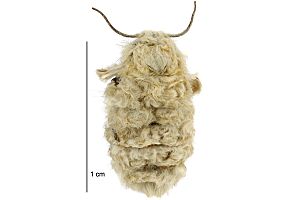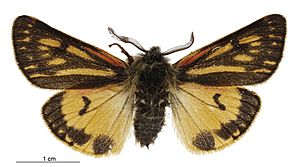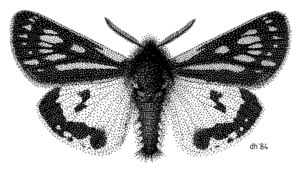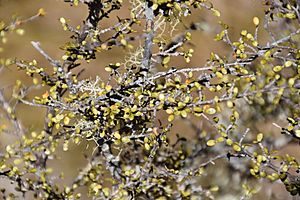Metacrias erichrysa facts for kids
Quick facts for kids Metacrias erichrysa |
|
|---|---|
 |
|
| Female specimen | |
 |
|
| Male specimen | |
| Scientific classification |
The Metacrias erichrysa is a special kind of moth that belongs to the Erebidae family. It is found only in New Zealand. You can spot this moth in the southern part of the North Island and in the western mountain areas of the South Island. The female moths cannot fly and are a plain, light brown color. However, the male moths are brightly colored and can fly very fast!
Contents
Discovering the Metacrias Erichrysa
This moth was first described in 1886 by a scientist named Edward Meyrick. He studied moths he found on Mount Arthur and also raised some from their caterpillar stage. Later, another scientist, George Hudson, wrote about and drew pictures of this moth in his books about New Zealand's butterflies and moths. The main specimen, called a holotype, is kept safe at the Natural History Museum, London.
What Does the Metacrias Erichrysa Look Like?
Adult male Metacrias erichrysa moths are very colorful and are active during the day. Female moths, on the other hand, are a dull, light brown color and have very tiny wings, which means they cannot fly.
The male moths are mostly black with bright orange-yellow markings. They have a thin yellow stripe along their front wings and other yellow spots and streaks. Their back wings are orange-yellow with a black band along the edge. The female moths are completely a light, yellowish-brown color, and their wings are very small. Their legs are short and strong.
Where Does the Metacrias Erichrysa Live?
This moth is found only in New Zealand. It lives in the high mountain areas of the lower North Island and the western mountains of the South Island.
Life Cycle and Habits of the Metacrias Erichrysa
The female Metacrias erichrysa moths stay inside their cocoons to mate and lay their eggs. When the tiny caterpillars hatch, their very first meal is often the body of their mother. After that, they spread out to find other food.
Caterpillars can be seen from mid-summer until winter. When winter arrives, they go into a special resting state called diapause, which is like a deep sleep, to survive the cold. The caterpillars then build a light cocoon to turn into a pupa. Some even build a small 'nest' before spinning their cocoon inside it. They usually attach their cocoons to rocks that cover them, rather than to the ground. Scientists think this helps protect the cocoons from melting snow.
Male moths fly around from mid-November to early January. They are very fast flyers and can be hard to catch! Male moths are drawn to females by special scents called pheromones. Interestingly, male Metacrias erichrysa moths can even be attracted to the scent of females from other similar moth species. Researchers sometimes use female moths as bait to find males in new places.
What Does the Metacrias Erichrysa Eat and Where Does It Live?
Adult moths prefer to live in open fields with herbs and tussock grasses in the mountains. They are usually found at heights between 900 and 1200 meters (about 3,000 to 4,000 feet) above sea level.
The caterpillars of this moth eat a plant called Brachyglottis bellidioides, as well as other grasses and herbs. Some of the native New Zealand plants they feed on include Festuca novae-zealandiae and plants from the groups Acaena, Muehlenbeckia, Wahlenbergia, and Raoulia.
Images for kids




